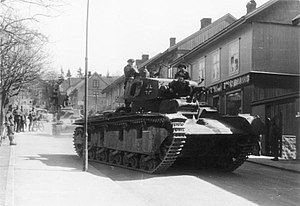| Neubaufahrzeug | |
|---|---|
 A Neubaufahrzeug V in Norway in April 1940 | |
| Type | Medium tank |
| Place of origin | Nazi Germany |
| Service history | |
| In service | 1935–1940 |
| Used by | Nazi Germany |
| Wars | World War II |
| Production history | |
| Designer | Rheinmetall Krupp |
| Designed | 1933–1934 |
| Manufacturer | Rheinmetall |
| Produced | 1934–1936 |
| No. built | 5 |
| Specifications | |
| Mass | 23.41 tonnes (23.04 long tons; 25.81 short tons) |
| Length | 6.65 m (21 ft 10 in) |
| Width | 2.90 m (9 ft 6 in) |
| Height | 2.90 m (9 ft 6 in) |
| Crew | 6 |
| Armor | 10–20 mm (0.39–0.79 in) |
Main armament | 7.5 cm KwK 37 |
Secondary armament | 3.7 cm KwK 36 3× 7.92 mm MG 34 machine gun |
| Engine | 290 hp BMW Va |
| Transmission | ZF SSG 280 |
| Suspension | coil springs |
| Fuel capacity | 457 liters |
Operational range | road: 120 km (75 mi) |
| Maximum speed | maximum: 30 km/h (19 mph) road: 25 km/h (16 mph) |
The German Panzerkampfwagen Neubaufahrzeug ("new construction vehicle"—a cover name), abbreviated as PzKpfw Nb.Fz, series of tank prototypes were a first attempt to create a medium tank for the Wehrmacht after Adolf Hitler had come to power. Multi-turreted, heavy and slow, they were not considered successful, which led to only five being produced. These were primarily used for propaganda purposes and training, though three took part in the Battle of Norway in 1940. Pictures of the Neubaufahrzeuge were displayed with different turret models and orientations to fool allied spies; American and Soviet agents independently reported that the Germans had two new heavy tanks, the Panzer V and VI. In reality, these tanks were far from the Panzer V Panther and the Panzer VI Tiger.[1]
- ^ Kavalerchik, Boris (2018). The Tanks of Operation Barbarossa; Soviet versus German Armour on the Eastern Front. Translated by Britton, Stuart. Pen & Sword Books. ISBN 978-1-4738-8682-7.[page needed]